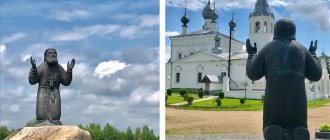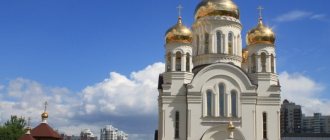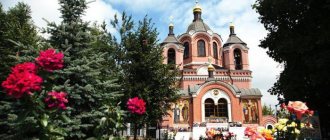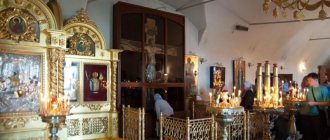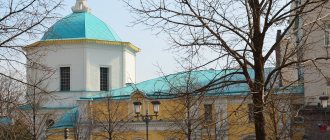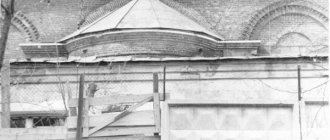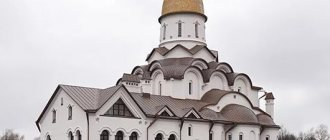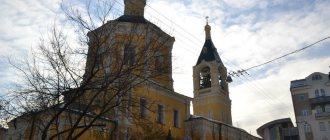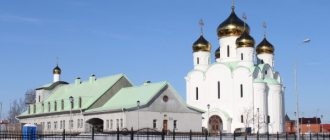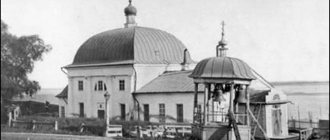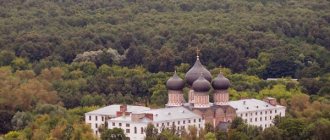The Church of St. John Chrysostom in the small village of Godenovo has become a popular place of Orthodox pilgrimage in recent years. People come to Godenovo not only from all over Russia, but also from all over the world. The reason for this is simple - it is in a small church in Godenovo that one of the main shrines of the Russian Orthodox Church, the Life-Giving Cross of the Lord, is kept. It miraculously appeared in 1423, during the most difficult time for Rus', and for almost six centuries Orthodox people have been going to this shrine in prayer.
How many tears have been shed before the Life-Giving Cross, how many fervent prayers have been said! And what is most amazing is that the Lord hears prayers said in front of this shrine in a special way. How many miracles and healings happen in Godenovo! People with cancer, whom doctors have already abandoned, are healed, infertile couples are given the opportunity to give birth to healthy children, drug addicts, who are completely immersed in this destructive passion, return to normal life, the blind receive insight, mentally ill and possessed people are healed. Many receive what they ask for in the most difficult life circumstances, when there is simply no one to expect help from. and everyone who receives what they ask for shares their miracle with their loved ones, and people come here in an endless stream - some to ask for a miracle, some to thank the Lord. Hundreds of gold jewelry fill the icon case, to which the Life-Giving Cross is located. These are offerings from grateful pilgrims, visible evidence of miracles granted by God through prayer before the Cross.
Historical events
According to legend, on the outskirts of the village there flowed a healing spring, the water of which healed all ailments. A small chapel was built next to the spring. In 1794, a majestic temple was erected not far from the chapel, using funds raised by parishioners. Later, in the 19th century, a chapel was added to the cathedral and a bell tower was erected.
The cathedral was spared war and destruction. Thanks to this coincidence of circumstances, the almost untouched architectural appearance of the church and its interior decoration, including magnificent frescoes that have been preserved since the initial painting, have reached our time.
The Life-Giving Cross in Godenovo played an important role in the modern fate of the temple. An hour's drive from Godenovo there is an ancient convent built in honor of St. Nicholas the Wonderworker. In 1997, the monastery received an arable land plot in the village. Godenovo. The sisters took the church under their wing. From that time on, the church belonged to the monastery.
The monastery itself is located 50 km from the village in the ancient Russian city, famous for its monasteries, Pereslavl-Zalessky. Despite the fact that the ensemble of the monastery itself was still at the stage of restoration, its abbess, Abbess Evstolia (Afonina), took care of the cathedral and the ancient Orthodox relic. The dilapidated temple was restored and heated.
Modern icon painters have updated the frescoes and icons and richly decorated the interior space. The road to the cathedral was paved. Soon it became part of the architectural ensemble. In the future, it is planned to build a pilgrimage center here.
On the vast territory allocated for the pilgrimage center, there will be several cathedrals, chapels, refectories, a hotel for numerous pilgrims, parking lots and a souvenir shop. Some things have already been done: a small baptismal church has been built, the foundation stone for the Hagia Sophia Cathedral has been laid, and a refectory has just recently opened.
The further fate of the monastery
Several times during its history, the St. Nicholas Monastery was destroyed and plundered. This was the case in 1381, when the Horde Khan Tokhtamysh, not wanting to accept defeat in the Battle of Kulikovo, made a campaign against Moscow and further to the north. N.M. Karamzin has a description of the death of Pereslavl: “The inhabitants of Pereslavl threw themselves into boats, sailed to the middle of the lake and thereby saved themselves from death; and the city was burned by the enemy.” Among those who survived were the monks of the St. Nicholas Monastery. When the fire subsided, they returned to the ashes to restore the monastery.
It then stood for almost 30 years and was again burned by the troops of Emir Edigei. Contemporaries wrote: “Everywhere there is darkness and sorrow... Many amazing signs also heralded the wrath of God: myrrh flowed from many holy icons or blood dripped.” The restoration of the monastery began only in the second half of the 15th century under Vasily III, during which the process of unifying the lands around Moscow was completed. Having been revived, the Nikolskaya “on the Swamp” monastery quickly became prosperous, had its own arable land and peasants, and also received generous donations from worshipers.
However, a new invasion - by Polish-Lithuanian invaders during the Time of Troubles - again destroyed the monastery.
Elder Dionysius, the future famous schemamonk and recluse, undertook to revive it. According to legend, even before taking monastic vows, he had a vision: St. Nicholas ordered him to someday renew the monastery in his name... After the death of Dionysius, Abbot Varlaam continued his work. He built a stone hipped bell tower, and in 1680 he founded the summer cathedral church in the name of St. Nicholas the Wonderworker. The construction was continued by Abbot Pitirim. It is noteworthy that he ended up in the monastery... as a schismatic. But, as monastic chronicles note, thanks to the spiritual influence of the monastery, he converted to Orthodoxy and, as often happens, became one of the ardent fighters against the schism.
The temple was completed under the next abbot - in 1721.
Architecture, appearance
The cathedral was built like a “ship”: the church, the refectory (or vestibule) and the bell tower are on the same axis. The cubic base of the temple, with a semicircular apse adjacent to the east, has five domes and a hipped roof. What is unusual about the building is that the hipped bell tower was built directly on the roof of the vestibule.
Such an architectural solution is quite rare in Russian church architecture. The quadrangle of the temple is an almost perfect cube, the corners of which are accentuated by decorative pilasters.
The cathedral was decorated in the style of Moscow church architecture of the 15th century, as evidenced by:
- window casings;
- multi-stage gables;
- keel-shaped kokoshniks;
- triangular cornices;
- promising portals.
The middle head has a light drum, the remaining 4 drums have dull drums. The apse repeats the decorative elements of the cube. The temple is slightly weighed down by the second aisle, which was added later on the northern side of the building. The aisle is very modestly decorated, repeats the heavy convexity of the apse and has one dome. In general, the temple ensemble looks quite harmonious.
In the architecture of the bell tower, slightly cut off by the refectory, one can see a typical octagon of a belfry tent, placed on a quadruple base. In the bell tier there is some asymmetry in the arched openings: wider ones are located in the north, south, west, east, narrower ones: northwest, northeast, southwest, southeast.
The gate and fence built later fit perfectly into the temple ensemble, almost repeating the decorative decoration of the cathedral. All buildings are covered with snow-white plaster, the roof is painted with silver paint.
Murals
Over time, they got around to decorating the interiors. In 2006, work began on painting the St. Nicholas Cathedral. By Easter 2007, the chapel of St. Demetrius was completely ready. Artist Alexander Derkachev decorated it with bright frescoes in the style of Moscow painting of the 14th-15th centuries. But his colleague Samson Marzoev, who worked in the chapel of the martyr Victor, chose a different solution - Byzantine motifs; at the same time, the walls began to look as if they were decorated with different types of marble. The altar paintings are also by Marzoev.
Interior decoration
Inside, the building splits into two volumes, which were already visible from the outside: the temple and the chapel that was added later. The room is unusually richly decorated. The walls, painted blue, from the floor to the domed vault, are painted with original frescoes made using the technique of 19th-century masters.
Huge images of saints are inscribed in window openings; on the walls, frescoes are framed and look like paintings. The altar is separated from the main part of the temple by a gilded 4-tier iconostasis. On the double-leaf royal doors there are icons of the Annunciation of the Blessed Virgin Mary and the four apostles, to the right of them is the image of the Savior, to the left is the Mother of God.
The gilded frames of the icons in the iconostasis and the frescoes decorated in the form of paintings look very harmonious and complement each other perfectly. In the narthex on the right wall there is a temple icon of John Chrysostom.
The Life-Giving Cross in Godenovo is located in the Bogolyubsky chapel.
It is decorated more modestly than the rest of the temple, but nevertheless plays a more important role. It is here that the main shrine of the Chrysostom Church is located. The crucifix is located to the right of the iconostasis in a fireproof glass case.
A single-row gilded iconostasis separates the middle part of the chapel from the altar. Ancient icons hang on the whitewashed walls. Among them is the temple icon of the chapel of the Image of the Bogolyubskaya Mother of God. There are no frescoes here.
Belfry
In 2004, construction of a belfry began at the cathedral. It was designed by the same architect Vyacheslav Izhikov. A set of bells, the largest of which weighs almost eight tons, were cast at the Tutaevsky bell foundry. And they were consecrated in May 2005.
In the same year, another significant event took place - Patriarch Alexy II served the liturgy and all-night vigil in the newly rebuilt St. Nicholas Cathedral. Then he presented Abbess Eustolia with the Smolensk Icon of the Mother of God.
Shrines
Like any ancient temple of the Yaroslavl Metropolitanate, the Church of St. John Chrysostom is rich in Orthodox relics. Numerous tourists and Orthodox pilgrims visit these places not only because of the well-preserved and restored temple. Most of all, they strive to see one of the main miraculous shrines.
The Life-Giving Cross attracts several thousand pilgrims here every year. They come to Godenovo to kneel before the main shrine of the Church of St. John Chrysostom, which is the Life-giving Cross of the Lord. For tourists, the relic is interesting as the oldest historical value of the 15th century.
Many wonderful legends are associated with the Cross. The very appearance of the Shrine is described as a miracle. According to legend, the Crucifixion appeared to local shepherds who were tending their flock near the Nikolsky churchyard in the summer of 1423. They saw a glow over the impassable Sakhota swamp.
When the shepherds with difficulty and fear walked to that place, they saw the Cross floating in the sky, and on it the crucified Christ, St. Nicholas stood nearby and held the open Gospel in his hands. And the Lord commanded the shepherds to build a temple on this place.
Having received the blessing of the Rostov rector, the people decided to build the church a little further from the swamp and had already laid the first crowns of the church, but it is not clear how, on the same night the construction was moved back to the place where the Crucifixion appeared. And in place of the marshy swamp, a small hill appeared.
A wooden church was built on that hill and consecrated in honor of St. Nicholas the Wonderworker. The Cross was kept in it for a long time. There was also a book in which all the miracles that occurred thanks to his life-giving power were recorded. In 1776, the wooden church burned down. The fire burned everything to the ground, including the manuscript. But when the residents came to the ashes, they saw the Shrine completely untouched by the fire.
A stone church was built on the site of a burnt wooden church. The Crucifixion was placed on the right hand of the iconostasis, and the icon of St. Nicholas on the left. In 1933 the temple was destroyed. The icon disappeared, and the Cross was secretly hidden by local residents. Later the Shrine was moved to the Church of St. John Chrysostom.
In 2002, the Life-Giving Cross of the Lord, newly restored by specialists from the Russian Museum, was placed in a fireproof icon case. A copy of the Crucifixion is kept in the St. Nicholas Monastery of Pereslavl-Zalessky. In addition, there are several more artifacts in the Goden Temple:
| Name | Description |
| Icon of John Chrysostom | The icon in honor of the Saint, after whom the cathedral is named, is located in the chapel, as well as in the form of a list in the iconostasis. Saint John Chrysostom is especially revered as a saint who brings peace and prosperity to families. The saint helps those whose profession is connected with the word: teachers, lawyers, media workers. The saint is the patron saint of students. |
| Icon of the Bogolyubskaya Mother of God | Many who come to the cathedral strive to fall before the Life-Giving Cross, but in the chapel is kept the icon of the Bogolyubskaya Mother of God, no less revered in Rus'. This image was copied a long time ago from the one kept in the Holy Dormition Monastery in the city of Vladimir. The icon painters restored it and the brightened face of the Mother of God began to look like it did in the times when it was painted. |
| The miraculous icon of St. Nicholas | In the chapel, to the left of the icon case, there is an icon of St. Nicholas the Wonderworker. This icon is strikingly different from most known images of the Saint: Nicholas the Wonderworker is depicted in full growth with a sword in his right hand. The historical name of this format of the image of the Saint is “Nicholas in height”. The same icon was given by Ivan the Terrible to the Feodorovsky Monastery in Pereslavl-Zalessky. It is now in the city local history museum. According to historians, the Goden list was made from it. |
In the church shop they sell miraculous icons of the already familiar Image of the Saint. These icons can bleed myrrh.
Shrines[edit]
- Life-giving Cross of the Lord
Godenovo Cross
The life-giving Cross of the Lord - one of the greatest shrines of Orthodox Russia - found its abode in the Temple in the name of St. John Chrysostom in the village of Godenovo, not far from the city of Pereslavl-Zalessky. The temple is part of the courtyard of the Nikolsky Monastery, and for many years the sisters have been leading the story of the Life-giving Cross of the Lord, which appeared to shepherds in the Sakhota swamp in 1423.
The life-giving Cross of the Lord was miraculously revealed to the shepherds of a nearby village in a swamp, 55 versts from the city of Rostov. Having seen the Life-giving Cross of the Lord above the impassable swamp in the middle of an indescribable pillar of light in the air, the shepherds, with the blessing of the bishop, began to build a church a mile away from this place. However, the foundation of the church they made by God’s will moved to the place of the miraculous phenomenon, over which the Life-giving Cross again shone. And they heard a voice from him: “In this place you will build my church.” That same night, after a strong storm, part of the swamp turned into a dry hill, where the church was built. After this, the revealed image of Christ’s crucifixion became visible and accessible to everyone. The past centuries preserve the history of many miracles and grace-filled healings from these shrines.
- The miraculous icon of St. Nicholas
Interesting facts and legends
In the 18th century The priest of the church on St. Nicholas Church decided to restore the first book with records of the miracles of the Life-Giving Cross. He asked local residents, studied ancient scrolls, and a new book emerged. It is still kept by the sisters of the monastery.
The entries begin with the appearance of the Life-Giving Cross before the shepherds and are further described:
- how a hill appeared in the middle of a disastrous swamp;
- how a cross untouched by the fire was found on the ashes of a burnt church;
- how the atheists could not destroy him: they burned, chopped, drowned;
- how the atheists could not take the Cross out of the church because it had become incredibly heavy
- how a resident of a neighboring village cut off the little finger of the Savior, and then he himself died of gangrene on the little toe of the same foot;
- how during the prayer service in front of the Shrine the lame began to walk, the blind began to see, the sick began to recover.
The sisters, taking care of their farmstead, do not forget about the book: they make new entries in it, often with medical documents attached, and give the book to everyone who wants to see it.
The Life-Giving Cross in Godenovo is mentioned in the description of many miracles associated with it.
Some entries are particularly interesting:
- Thanks to the parents of a 9-year-old girl, she was completely cured of epilepsy. Before this, no medications helped her. After her parents took her to the True Cross at the age of 4, her attacks became less frequent, and now she is healthy.
- A letter from a woman with stage 4 cured cancer, enclosing doctor’s notes before and after her trip to the temple.
- The guy who visited Afghanistan was confined to a wheelchair for a long time. He spent years almost without moving, and then asked his relatives to take him to the Godin Cross. After the liturgy, the man rose to his feet.
- Record of a man who had severe renal colic. The doctors could do nothing to help him. He decided to turn to the Cross for help. After a trip to the village. Godenovo, a pointed stone came out and the pain stopped.
Descriptions of healings can be continued endlessly. People got rid of severe forms of incurable diseases: cancer, tuberculosis, severe injuries, and mental illnesses. One had only to venerate the Life-Giving Cross and pray fervently, as the immobile rose to their feet, and the possessed, after unusual seizures, became calmer.
Many miracles of healing are described in the book. But not only the original Crucifixion has miraculous powers, but also copies made right there in the Godin Church by skilled craftsmen. Copies of the Life-Giving Cross are kept in 12 Orthodox churches. And wherever a copy appeared, miracles happened.
- One copy was brought to Sevastopol during the Maidan. Residents fervently prayed for peace. Soon the inhabitants of Crimea became Russians.
- One of the Lugansk churches where the copy is located was never damaged during shelling.
There are many entries in the book of healthy people who found peace and peace of mind after visiting the Goden Church.
War on the Cross
And sixty-five kilometers away, in the village of Antushkovo, there was a real war with the Life-Giving Cross! The new authorities seriously decided to deal with the shrine. At first the plan was to simply remove it from the temple in which it was located. However, the relic suddenly became... unbearable. But before, during religious processions, she was repeatedly taken out of the church! Then the vandals tried to saw the Cross. But, not subject to the elements of fire, the Crucifix did not succumb to axes - as if it were made of stone. Then the temple was locked, and guards were posted at the doors. But the parishioners, having bribed the guard, took the Cross out of the St. Nicholas Church and secretly delivered it to Godenovo at night. The cross was hidden in the Church of St. John Chrysostom. Exactly when this happened is unknown, but, according to Vera Kirsanova, a native of the village of Zakharovo, the transfer took place in 1933. Since then, the Cross has been taken care of, but it was, of course, closed to public worship until 1997.
Opening hours and schedule of services
The Life-Giving Cross in Godenovo is available to parishioners and pilgrims only during church opening hours. The temple is open daily from 7.30, it is at this time that the service begins on weekdays, on Sunday morning service begins at 8.45. until 20.00. Liturgy takes place at 9.00. The evening service begins at 17.00. At this time, there is an opportunity to visit the temple and worship the Shrines.
You can venerate the Cross only from Friday to Sunday, as well as on patronal feasts:
- 3rd week of Lent (Worship of the Cross);
- June 11 (day of the appearance of the Crucifixion);
- August 14;
- September 27.
Nikolsky Monastery after the revolution
From the Renovationists, priest Alexy Chizhov and his associate Abbess Aglaida came to the St. Nicholas Monastery. But not for long. Soon they too had to, as they say, vacate the premises. The Soviet government decided, as happened in hundreds of Russian cities and villages, to adapt the monastery territory to its needs. And for this it was necessary to demolish everything that was “in the way.” So, the St. Nicholas Church, the bell tower and... for some reason the fence seemed “superfluous”. A livestock breeding base was placed in the former residential buildings and utility block, and a boarding school for sick children was set up in the cell building. People were housed in the remaining rooms, including temple altars.
Contacts
The village of Godenovo is located in the Rostov district of the Yaroslavl region. You can call from 11.00 to 15.00 at +79622068215 daily, except Sunday.
Contacts:
- Address: 152130, Yaroslavl region, Rostov district, Godenovo village.
- Fax: 8 (48535) 3-06-45.
You can arrange a group excursion via email or website.
Finding the relics
Another important aspect of the life of the restored monastery is the discovery of the relics of various saints. We are talking, for example, about the relics of the blessed Prince Andrei of Smolensk - they were miraculously preserved from desecration, as well as the relics of the Pereslavl wonderworker Cornelius - for a long time they were kept in the Nikitsky Monastery. In addition, several years ago, the Ryazan diocese handed over a priceless gift - a particle of the relics of St. Nicholas, which is now in the ancient image of the monastery’s patron saint. And the governor of the Kyiv Chinese hermitage, Archimandrite Prokhor (Kostyuchenko), sent particles of the relics of the Kiev-Pechersk saints - now a gilded ark has been made for them with donations from the patron.
Several years ago, a copy of the Life-Giving Cross from the church in the village of Godenova was installed in the monastery.
Monasteries of the Yaroslavl region.
How to get there by car, public transport
It is best to do this in your own car. Along the M-8 highway to the town of Petrovskoye. It is about 195 km. In the city you need to turn right, and there are already signs to the village. The road to the village is well paved and driving a car is not difficult.
It is more difficult to reach by public transport, but you can:
- From Moscow you need to take the intercity bus “Moscow-Yaroslavl” to the city of Petrovsk, and then take a local bus that goes towards the village. Priozerny to the village;
- From Yaroslavsky station by train to the station. Petrovsk, then on the same bus.
Driving your own car can be a great experience. On the way you can visit the city of Pereslavl-Zalessky, where the St. Nicholas Convent is located. This ancient town is famous for its monasteries, churches (the first stone church of the 12th century is located here), and museums. There are two healing springs here, the wonderful Blue Stone and the Botik of Peter I.
By car you can also get to the village. Antushkovo, where the Monastery of the Descent of the Cross is located. It was built on the spot where, according to legend, the Life-Giving Cross appeared before the shepherds.
A very convenient way to visit a holy place is to buy a sightseeing tour. Then you won’t have to think about accommodation, food, or travel. In addition, excursions around the Yaroslavl land are very interesting and eventful.
There is another way to see the temple. This is to join the pilgrims' journey. Advertisements for such trips can be seen on the Internet or at the doors of temples. Such trips usually also include visits to several holy places.
Ktitor
The year 1997 was marked by another significant event: the monastery got its own ktitor - Viktor Ivanovich Tyryshkin. Even in his youth, he realized that he was marked by the patronage of St. Nicholas the Wonderworker. One day, a young man was driving a car to the railway station to return to St. Petersburg, where he studied at the Military Academy. Before leaving, his mother gave him an icon of St. Nicholas with her. At some point, the driver lost control and crashed into a bus stop. The car crashed into pieces, the driver died, but the young man remained unharmed. In gratitude for the miraculous salvation, Victor began to visit all St. Nicholas churches and monasteries that he came across. So one day he ended up in the Pereslavl monastery. I met the abbess, learned that the monastery's St. Nicholas Cathedral had not yet been restored, and began to take an active part in the life of the monastery and in its revival.
Infrastructure
There is a toilet in the parking lot. There is also a tent nearby where you can snack on delicious pies and hot tea. A refectory has recently opened where you can order hot lunches or snacks.
Unfortunately, the temple ensemble is located far from all major settlements and, therefore, there are no hotels, cafes, restaurants or other amenities of civilization nearby. Probably because people come to Godenovo for a short time.
Apart from the Life-Giving Cross, the Temple and the Baptismal Church, there are no other attractions here yet. Tourists and pilgrims who travel to holy places can stay in nearby cities: Rostov or Pereslavl-Zalessky.
Cost of a pilgrimage trip to Godenovo:
1 700 R. per person.
If you want to travel with your group (less than 15 people), the price is discussed individually.
Please note that when a group of more than 15 people is going on a trip, there is a 200 ruble discount for pensioners and children under 12 years old, and a 400 ruble discount for disabled people, large families, and monastics. Priests can travel with the group for free.
Book a trip to Godenovo to the Life-Giving Cross.
Book your trip now!
Contact us by phone: +7 (from 8:00 to 21:00 Moscow time)
sign up for a trip via WhatsApp chat
or request a call back and we will call you back,
or use the order on the website,
or send us an email to [email protected]
or use Viber to communicate (single number +7)
